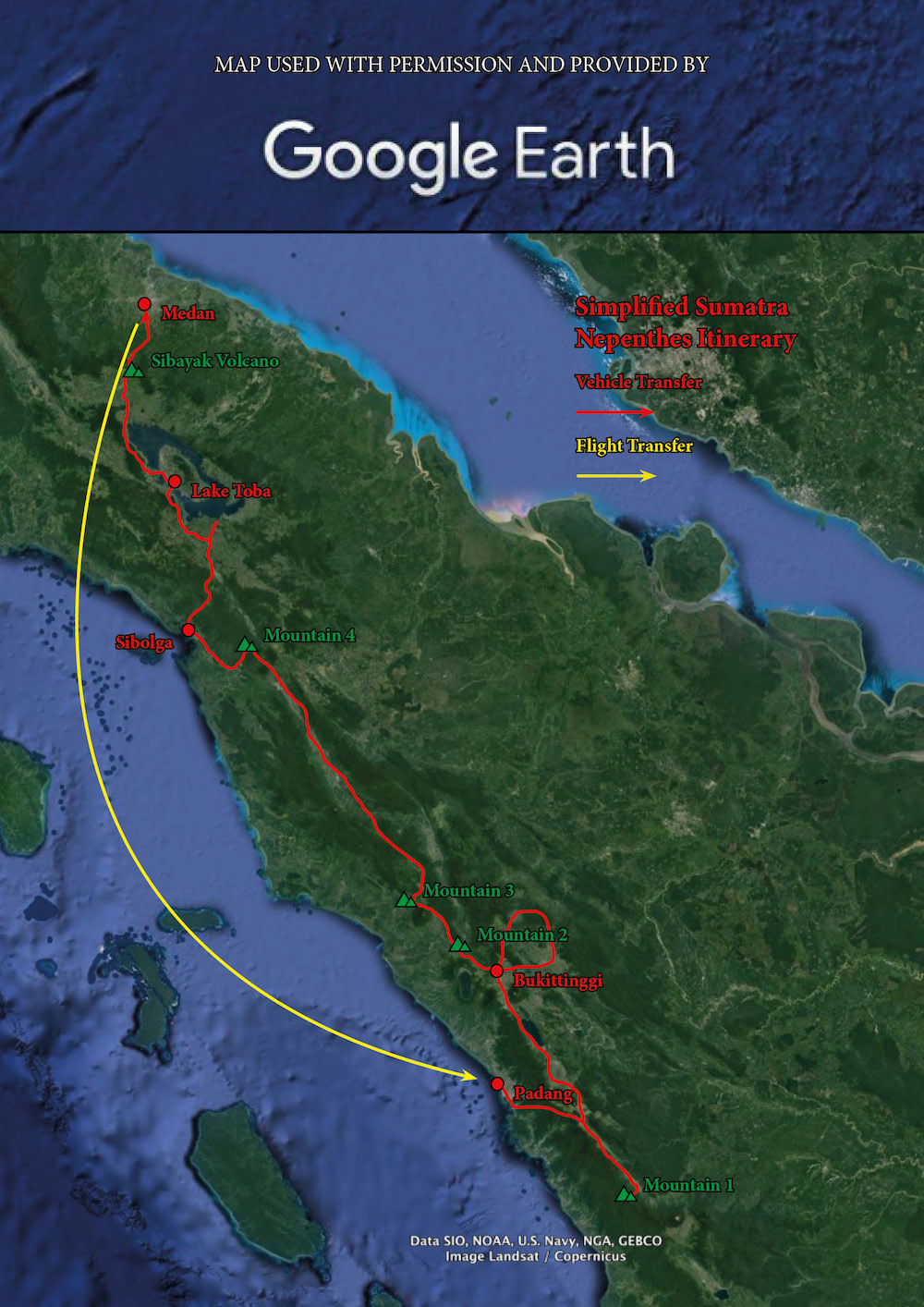Nepenthes OF SUMATRA EXPEDITION
Sumatra is home to arguably the greatest diversity of carnivorous pitcher plants of the world. A total of 37 known species are found on this biologically rich island, along with tigers, rhinoceros, elephants, countless orchids, and the biggest flowers on earth: Rafflesia and Amorphophallus.
This expedition takes you on a 16 day itinerary to see many of the most spectacular Sumatran pitcher plants in the wild, along with a diverse range of other wildlife highlights. We will trek through pristine rainforest, mossy cloud forest, and up to the summits of dormant volcanoes to observe Nepenthes in their natural habitats. Along the way, we will have the chance to encounter orangutans, macaques, a vast diversity of birdlife, Paphiopedilum and countless orchids, and (with luck) open blooms of Rafflesia arnoldii and Amorphophallus titanum. During the itinerary, we can visit fascinating Minangkabau villages to witness their unique culture, sample their exquisite food, and observe their impressive “bull-horn” houses and rice barns – some of which are more than 300 years old! As we travel south during the trip, we have the opportunity to visit the extremely impressive Minangkabau Royal Palace!
Key Facts
COST: £3,150 (British Pounds). Personal porters can be hired at extra costs (contact us for details).
START POINT: Medan, Sumatra, Indonesia.
END POINT: Medan, Sumatra, Indonesia.
DATES: Redfern Adventures will run three trips this year: Trip 1 in April, Trip 2 in June/July/August and Trip 3 in November/December. Please email us for the exact dates. We will finalise the group of participants, then finalise the exact dates for each trip to best fit everyone’s schedules.
GROUP SIZE: 6–10 (on double/twin room basis – single room supplement available).
BESPOKE TOUR: If you do not wish to join a group tour, we can customise a private trip to suit your dates and interests. Please email us for details.

Getting there: Medan is served by various airlines including Silk Air (Singapore), Malaysia Airlines and AirAsia (Kuala Lumpur, Penang) and Garuda Indonesia (Jakarta, Singapore). Many find it most economical to fly to Singapore and catch low-fare flights to/from Medan (e.g. AirAsia, Silk Air or Lion Air).
Itinerary
Note:
Precise location details in this itinerary are masked due to the sensitive nature of the sites visited.
Day 1:
Medan to Padang flight. Following pickup, we drive south to a large protected area that includes a number of volcanoes; it is home to a wide diversity of plants and animals, including the endangered Sumatran Tiger.
Day 2-4:
We ascend our first mountain, hiking to over 2000 m elevation where we break camp for the evening. Although this is tiger territory and the group is required to stay together, there are opportunities to explore the nearby forest before nightfall. On Day 3 we hike to a ridge overlooking our camp in search of the unusual Nepenthes aristolochioides. The mountain is also home to red and green forms of N. gymnamphora as well as the striking N. singgalana. On Day 4 we descend to the jump-off point and drive north to our next site of interest.
Day 5:
Today is a rest day, but to keep our muscles primed, we journey to a nearby valley in search of Nepenthes adnata. Nepenthes longifolia, N. albomarginata and occasional other lowlanders are sometimes seen. If in flower, there is also a chance to encounter Rafflesia arnoldii, the world’s largest bloom, and possibly Amorphophallus titanum, the world’s largest compound inflorescence!
Day 6:
Travelling onwards, we arrive at the base of our next mountain by evening, with a view to ascend tomorrow.
Day 7:
Following an early breakfast, we make a one day ascent of the mountain; this is a long but non-technical trek of 5 hours to the summit. We encounter N. gymnamphora, and thereafter N. izumiae and N. jacquelineae and potentially their hybrid. We start our descent to the base by 2pm, arriving in the lowlands around 6pm. After dinner, we travel to the base of our next mountain, where we check in to our lodge and overnight. A long but hopefully rewarding day!
Day 8:
We climb the steep slopes of the mountain to the pre-summit campsite where we overnight. Nepenthes naga is documented on this mountain as a high epiphyte and may be difficult to spot.
Day 9:
Following an early breakfast, we ascend 1 hour to the nearby summit where N. jamban, N. lingulata, N. izumiae and N. spec ‘taminii’ can be found, along with few, but large plants of N. dubia. We start to descend by noon to the base of the mountain, arriving by sundown. We dine and overnight in a nearby town.
Day 10:
A well-earned rest day in which we travel to a town located near the base of our next mountain.
Day 11:
In the early morning, we travel to the jump-off point and begin our climb, gaining as much elevation as possible before camping close to a small stream.
Day 12:
Starting as early as possible as it is a long day of trekking, we pack up camp and, with our day packs only, ascend to the summit; en route we encounter Nepenthes gymnamphora, N. rhombicaulis, an epiphytic species similar to N. ovata and, for those who are able to make the summit, N. flava. We descend to the base arriving towards sunset. We return to town for dinner and a well-earned rest.
Day 13:
Today is a proper holiday. We travel to the coast, stopping en route to study N. sumatrana. After a quick lunch, we head into the hills to visit a very rich site for lowland species, including N. sumatrana, N. longifolia, N. rafflesiana, N. ampullaria, N. gracilis, N. eustachya red and N. eustachya white, along with their hybrids.
Day 14:
We travel towards Lake Toba via a site known for its black N. tobaica. We check into our accommodation close to the lake.
Day 15:
We travel to the volcanic slopes of Mount Sibayak via the former site of Nepenthes rigidifolia. Although this species has been rendered extinct by poaching, N. spectabilis abounds and the rare N. rigidifolia x spectabilis hybrid may remain.
Day 16:
We return to Medan in time for a farewell lunch and flight departures from early afternoon onwards.
Please note:
A degree of flexibility has to exist with expeditions in Sumatra due to the nature of the roads and weather conditions. As a group, we can may need to tweak the plan as necessary during our travels.





















